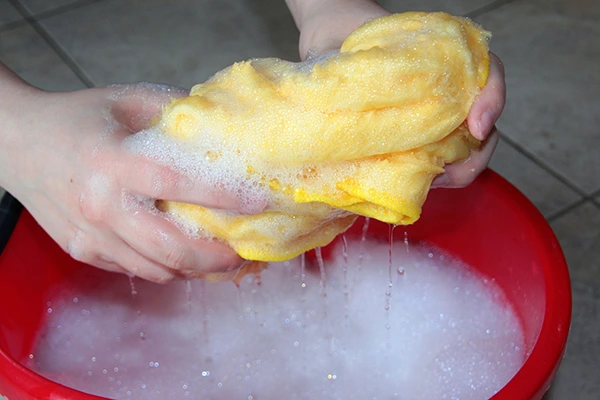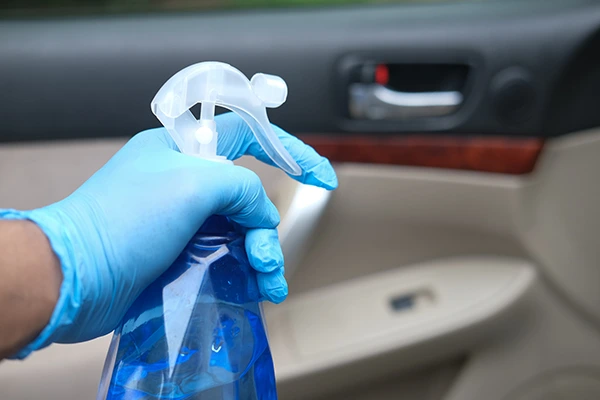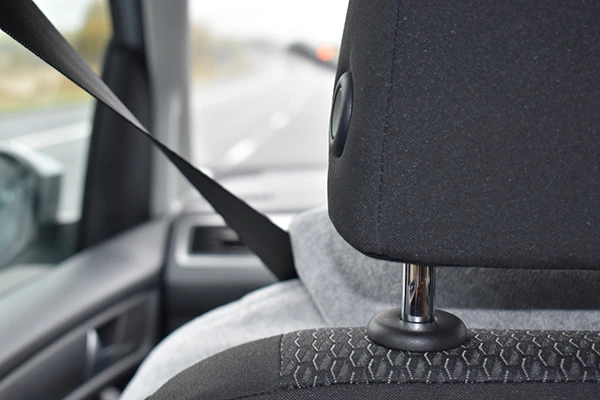Every car owner loves that fresh car smell, especially right after it’s been in the wash. But, while the car wash does a great job of cleaning four-wheelers on the outside, they can’t catch what’s on the inside, which is often even more important. Here’s how to clean seat belts with your stuff at home and professionally.
For simple yet effective seat belt cleaning, you’ll need some dish soap, lukewarm water, a towel, clamps, and a bucket. For a more professional deep clean, you can also purchase fabric cleaner, an all-purpose cleaner, and medium and soft-bristled brushes. Both methods work well in taking care of your seatbelts.
What Is a Seat Belt in a Car?
For anyone starting their car journey, we’ll quickly introduce you to the history and purpose of the seat belt. Seat belts were invented during the late 1800s to protect pilots. We have the English engineer George Cayley to thank for that.
During the 1880s, an American inventor Edward J. Claghorn patented the seatbelts, and taxis across NYC were forced to have them for customer protection. However, they weren’t mandatory in all cars until the late 1960s. Since then, seatbelts have become one of the essential safety features in vehicles and are now required in all states.
Wearing a seatbelt can save your life in a car accident, as they keep you from being ejected from the vehicle and help to absorb some of the impacts of the collision. This brilliant invention can prevent serious injuries or even death. According to the National Highway Traffic Safety Administration (NHTSA), seat belts reduce the risk of fatal injuries by 45%.
Seatbelts aren’t necessary just for drivers, but for passengers, as well. It used to be OK for passengers in the back seats not to wear them, but now, every passenger must, and that’s a rule in most (if not all) states.
If you’re involved in an accident, and one of your passengers is not wearing a seatbelt, you could be held responsible. So, besides only learning about cleaning a steering wheel and the rest of the interior, it’s vital also to know how to clean seat belts and keep them in good condition – they’re life savers.
Parts of a Seatbelt
Here’s a quick rundown of parts of the seatbelt and their functions.
| Part Name | Function | Where is it? |
| Retractor | Distributes webbing in and out and locks it in a fixed position when yanked abruptly, like in collisions. | On the lower left side of the seat (driver and passenger behind them) and the lower right side (passenger). |
| A pillar loop | Allows the webbing of a seat belt to be pulled out or retracted for comfort. | Fixed to the area over the shoulder of the driver or passenger. |
| Webbing | This is the belt itself. | It comes from the retractor, through the pillar loop, and into the buckle, wrapping around the passenger or driver. |
| The latch plate | Slides up and down on the webbing and locks it in place when inserted into the buckle. | On the webbing (seatbelt). |
| Buckle | The part where the latch plate is locked into. The latch plate snaps into the buckle and stays locked until manually released. | Opposite the retractor; the right side for the driver and passenger behind them, and the left for all other passengers. |
Why You Should Clean Your Seat Belts
Keeping your car clean is crucial, from removing dog hair if you travel with pets to cleaning the nooks and crannies. However, when people do take the time to polish their four-wheelers, they often miss one important thing – the seat belts.
Surprisingly, this integral part of a vehicle is often overlooked when it comes to cleaning, so raising some awareness on why that’s so important is crucial. Here’s why you need to clean your seatbelts at least once a year if not every few months.
How to Clean Seat Belts Professionally
Fortunately, it’s never too late to grab your seatbelts and give them a good scrub. You can get some professional cleaning equipment if you’ve never cleaned the webbing before, and ensure it gets washed thoroughly.
Pull the seat belt out of the retractor and place a medium-sized clamp next to the pillar loop. This will prevent the webbing from retracting back into default automatically.
When the clamp’s in place, spray it with fabric cleaner (I use Chemical Guys brand) and scrub with a medium-bristle brush (Songtaste brushes have the most comfortable handles). Try to scrub in the direction of the fabric, not against it, as that can thin out the webbing.
If you have access to a steam machine, you can spray fabric cleaner all over the webbing and then spray it with steam to completely remove germs and dirt. In case of persistent staining, soak a brush in half a cup of all-purpose cleaner and then scrub away.
Let the belts air dry naturally, or speed up the process with a hair dryer (or any other drying tool). You can remove excess moisture by rubbing the seatbelt with a dry towel.

What You’ll Need for This Process
For this more “professional” method, you’ll need to invest in some brushes and cleaners. Here’s the full-length shopping list:
- Medium-bristle and soft-bristle brushes (one of each is enough),
- Fabric cleaner,
- All-purpose cleaner,
- Clamp (medium-sized, to hold the webbing in place),
- Dry towel,
- Plastic cup (for soaking the brush in an all-purpose cleaner).

How to Clean Seat Belts Without Buying Any New Products
If you need a quicker and cheaper solution to cleaning your seatbelt, there is one. You won’t need anything more than a bucket of lukewarm water and some dish soap. For this, you’ll need the clamp again, as you need something to keep your seatbelt in place.
Firstly, pull out the seat belt from the retractor and place the clamp near the pillar loop when most of the webbing is out. Dilute dish soap in a bucket of lukewarm water until it foams up, and then soak the seatbelt in it.
It doesn’t matter if it can’t all fit into the bucket, as you’ll later use the medium-bristle brush to reach and clean other parts. Place a towel on the seat before putting the bucket on it and soaking the webbing; let the whole thing soak for about an hour.
After soaking, take the webbing out of the bucket and place it outside the car. Dip the medium-bristle brush in water and gently rub the unsoaked parts of the webbing along the fiber, not in circles.
After scrubbing, leave the clamp and let the webbing dry overnight. You can place it on a towel or let it sit directly on the seat but don’t retract the wet webbing back into the retractor, as the water can get stuck and cause issues.
You can also speed up the drying process by using a hair dryer, but your best bet is to let it sit for 24 hours.
What You’ll Need (Mostly From Your Kitchen and Bathroom)
For the home-friendly seatbelt cleaning version, you won’t need to go shopping. Here’s what you’ll need to get:
- Bucket (or anything that can hold a lot of water),
- Dish soap,
- Dry towel,
- Clamp,
- Hair dryer,
- Medium-bristle brush.

Removing Odors From Seat Belt Fabric
In case some bad odors are stuck to your webbing and you need it out fast, you can use one of the oldest tricks in the book – mixing white vinegar with dish soap and water and rinsing the smelly spot.
If you have a spare spray bottle, use it to dilute the following amounts:
- One cup of water,
- One tablespoon of dish soap,
- Two tablespoons of white vinegar.
Mix it all well and spray the bad-smelling area with the mixture; white vinegar works as an antibacterial agent and removes bad odors, as well as stains and dirt. It can also be a part of the overall cleaning experience, not just used to remove bad smells. If you don’t have a spray bottle, mix it all in a cup and soak the brush in the liquid for a bit. This should be enough to remove the stain and smell from your seatbelt.

How Often Should You Do This?
When we wonder about replacing tires, cleaning seat belts, and changing the U-joint, we often wonder ‘how’ and rarely ‘how often.’ You may not need to know all about adding brake fluid if someone else can do it for you, but it’s your job as a car owner to know the best times to do all these things.
Since dirt on the seat belt might interfere with its functions, which is all passengers’ safety in traffic, it’s recommended to clean it at least once a year, perhaps twice. This should be done whenever you notice dirt, grime, and stains collecting around the area.
If it’s easier, try to keep a calendar of times you cleaned or replaced something on the car. That will give you insight into the following year and obligations around your four-wheeler. As long as you notice these issues and take action, you and your passengers will be safe.

Keeping Your Seat Belts Clean Increases Your Car’s Safety
Cars are tools that take us from one place to another, but they’re also filled with hazards and risks if operated wrongly. Keeping them in great shape is integral to safety and risk-free driving, which goes for the interior, too.
Cars don’t go through technical check-ups once a year for nothing. They can be dangerous in the wrong hands and with the wrong operator, so going through the mandatory condition examinations is a small price. They won’t exactly check the cleanliness of your seat belts, but it’s crucial to clean them because that could easily save your life and increase the vehicle’s safety. If you love your four-wheeler, you’ll take the time to do this; hopefully, you’ll have an hour or two this weekend.








